radiopej
Enlightened
For consideration for the reviews section.
Disclaimer: This light was sent to me for free by Klarus. However, all opinions presented here are mine and I stand by them.
Manufacturer's Specifications
Emitter: CREE XP-L HI V3 (Cool White)
210 m throw
Type III Anodised Aluminium
Smooth Reflector
Strengthened ultra-clear glass lens with anti-reflective coating
Battery type: CR123A x 1, 16340 x 1 (dual springs for impact resistance)
· Working voltage of 2.0V-4.2V,
· Comes with 1x 700 mAh Klarus 16340 battery
2 groups of modes
· Tactical setting
· Hunting setting
Pocket clip – acts as an anti-roll device
Dual tail switches,
Instant strobe (from off)
Water-proof to 2 m (IPX-8 standard)
Impact resistant to 1 m
Length x diameter (head / body): 85 x 25.2 / 23.2 mm
Weight: 47.5 (without batteries)
ITS Smart Temperature Control System
Output – Manufacturer's Specifications
Since the FL-1 standard is supposed to be based on the included battery, these run times from Klarus should be based on their 700 mAh battery. I couldn't measure tailcap current, as the light disassembles in such a way that it was exceedingly difficult.
On 16340
High (700 lumens): 50 mins
Mid (100 lumens): 3 h
Low (5 lumens): 53 h
Strobe (700 lumens): 1 h 40 mins
SOS (100 lumens): 9 h
Peak Beam Intensity: 11,025 candela (210 metre range)
On CR123
High (400 lumens): 1.5 h
Mid (100 lumens): 5 h
Low (5 lumens): 108 h
Strobe (400 lumens): 3 h
SOS (100 lumens): 15 h
Peak Beam Intensity: unknown
Included in Package
1x Klarus XT1C Flashlight
1x Klarus 700 mAh ICR 16340 battery
1x Lanyard
1x Spare O-Ring
1x Pocket clip
1x User Manual
Initial Impressions
I am a massive, massive fan of the Klarus XT11S, but wanted something a little more portable for when I couldn't pop it in my jacket. I love my Olight M10, but since Olight wasn't planning to make a new version, I've been looking for something more current as a single CR123 light. I got rather excited when Klarus announced the XT1C, and told my girlfriend if I couldn't get one to review, I'd buy it anyway. Fortunately, I managed to get a review sample in the interim. Unfortunately for my girlfriend, I'm probably going to buy some more of them when my income stabilises.
The light comes in a soft plastic box. Yes, it looks cheap, but I prefer it this way – I'm sick of feeling like I need to keep boxes because they're more solid. When they're nice and cheap I can throw it out right after opening.
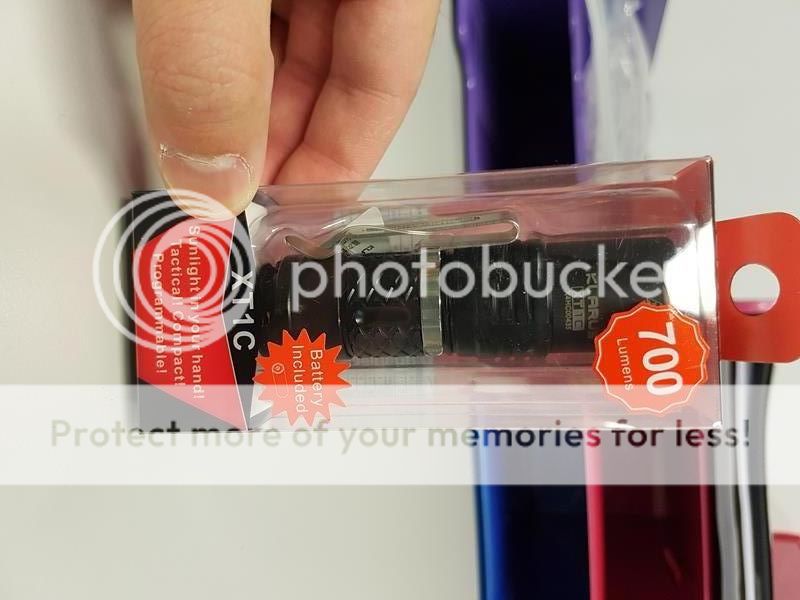
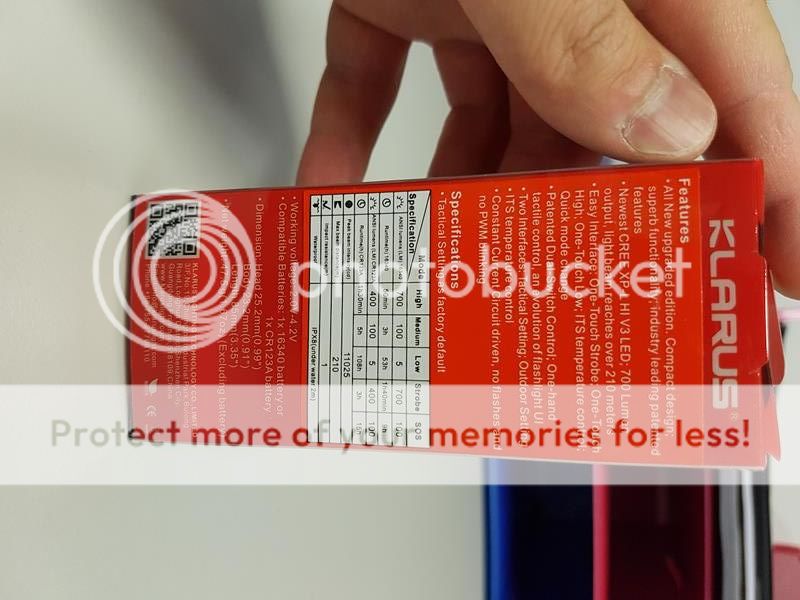
Like the XT11S before it, this light is solidly built. However, rather than just shrink down the XT11S, Klarus seems to have just taken the elements that made it work and rebuilt a smaller light from scratch with the main goal of portability. The side button is gone, the crenellations are gone and so is the USB recharging. What functionally remains is the beautiful XP-L HI beam and dual tail switches.
The first thing you notice when you turn it on is that the mechanical on/off switch has been replaced by an electrical switch. Some hate these, some love them. I was surprised, but it works quite well, and likely contributes to the size of the light.
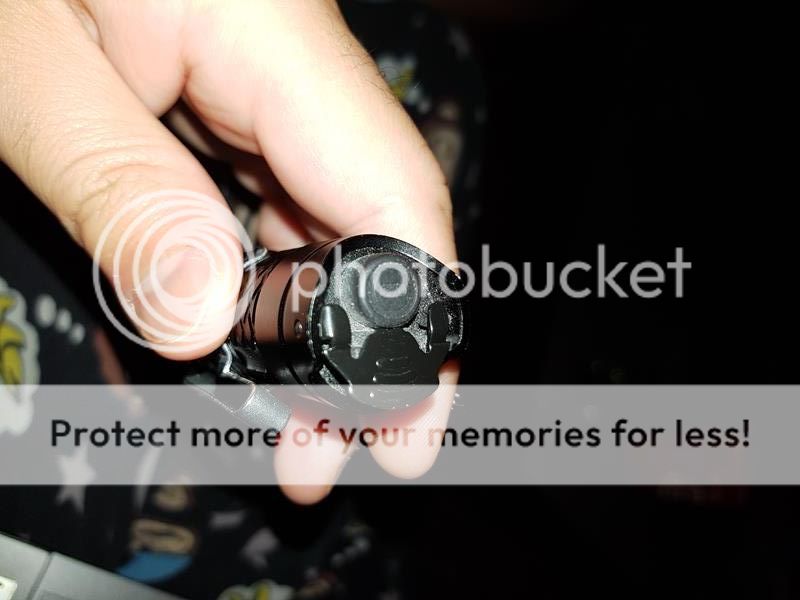
By dropping the additional mode group on the XT11S and the control by the side switch, the user interface has been greatly simplified. It's now a light you can just hand to somebody, although there's a chance they'll strobe themselves.
Physical Characteristics
This thing is a baby tank. It's pretty similar in size to the Olight M10, although slightly shorter. There aren't any crenellations, so it's less likely to be considered a weapon anywhere. I kind of miss the crenellations, and legitimately used them to check if the light is on. I think Klarus would have done well to include a removable and interchangeable bezel to allow users to decide on this for themselves. However, as it's designed to be a back-up, ultraportable light this is forgivable. The pocket clip is mounted nicely and stays where you leave it.
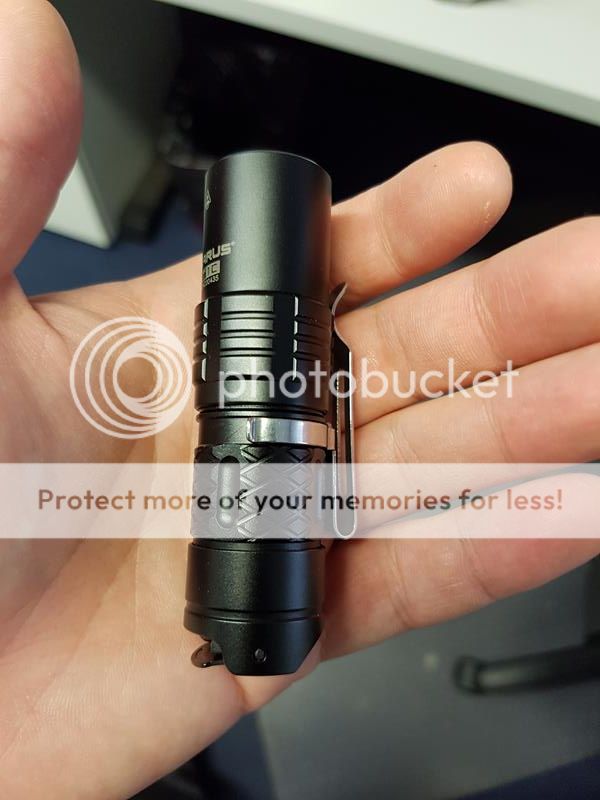
There are cutaways on the tail cap shroud, but the light can still tailstand. This isn't a very stable tailstand at all, but it's physically possible. The LED is nicely centered and the diamond knurling is quite clean, if minimal. A little more knurling would be good, but it didn't slip out of my hands as it is. The light is controlled by just 2 switches. One is an electrical on/off switch (which I'll refer to as the tail switch) and a separate electrical mode/strobe switch (I'll refer to this as the flipper). As mentioned elsewhere in this review, Klarus has opted for a digital/electrical switch rather than a mechanical one. I miss the feel of the mechanical switch, but the digital switch does work quite well. You don't get a momentary mode but it's much faster to push.
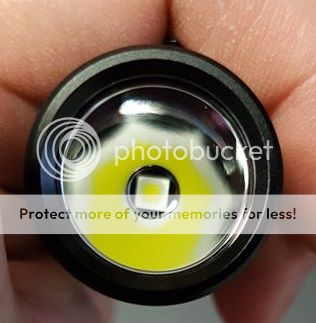
The feels slightly heavier than the Olight M10, but only barely. I keep it on my belt and frequently forget that it's there. I would prefer to have built-in USB charging, but once again, it would appear that Klarus sacrificed this to shrink the light as far as they could. It's acceptable, but a little sad considering how brilliantly this feature was integrated in the XT11S. Dropping the light a few times didn't cause any damage to the light, even the flipper. So I dropped it out of my second storey window onto the grass outside. It was still fine. Many people think the flipper switch is a structural weak point, but in using 3 lights with these, I haven't seen anything to suggest this. I even pulled it back all the way, and it just flips right back. It's not actually a switch itself - it's mounted just above another electrical switch. It just gives you better surface area to push down on, and physically differentiates it from the on/off switch. The only problem is that it's mounted a little loosely - this is intentional, to allow you to press the flipper down freely, but if you shake it you can hear it gently rattle. Once again, not really a problem in use at all, but some of us are sticklers.
The interior of the light is 17 mm wide, happily handling the ~16.5 mm included battery without any battery rattle at all.
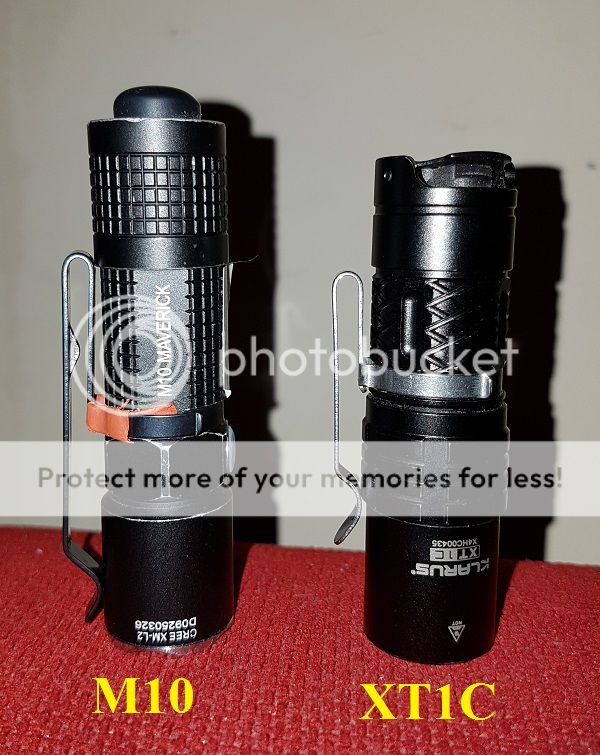
The light handles heat decently. It gets hot after only a couple of minutes, but never went over 48 °C. For me, my hand burns at temperatures above 40°C, but most people I know can easily tolerate 50°C.
User Interface and Modes
XT11S allows you to choose between 2 groups of modes, both of which feature instant high mode by pushing the tail switch from off. The flipper also acts as a mode selection switch once the light is turned on.
Switching between groups is easy once you get used to it, though the manual is a little confusing at first. Basically, from ON you hold the tail switch for 5 seconds. You need to just keep holding the button down until the light starts flashing like a low strobe. While continuing to hold it down, you press the flipper switch to cycle between groups. The light will then flash either once or twice.
The mode groups are (in order):
1 - Tactical group: On this setting, the tail switch activates high and the flipper activates strobe as a momentary switch. Holding the flipper down for two seconds leaves the strobe on continuously until you press the flipper again. If the high switch is activated, pushing the flipper then cycles down from high to medium, then to low and back to high again. Holding the flipper down for 2 seconds while in normal usage activates the strobe. Pressing the flipper down again takes you out of strobe to high.
2 - Hunting group: The tail switch activates high, the flipper switch activates momentary low. Holding the flipper down for two seconds leaves the light on continuously until you hold the flipper for another 2 seconds or the tail switch again. Pressing the flipper while the light is already on will cycle through modes, but this time in reverse – low, medium, high. Holding the flipper for more than 3 seconds when the light is on will activate SOS. There is no strobe in this group.
Once a group is set, you can't really accidentally change it, so I like that getting to the group is a bit laborious. You only really need to change it a couple of times to figure out what group is best for your needs. I liked the hunting mode on the XT11S, but preferred the tactical mode on the XT1C. This is because the side switch on the XT11S allows for strobe, whereas there is no strobe on hunting mode on the XT1C. It's quite easy for me to use high and strobe urgently, and spend half a second longer switching to low when needed. I might actually switch to using this on the XT11S now too. My girlfriend would rather have instant access to strobe rather than messing around with clicks, so I'll likely pick one up for her eventually.
For police officers (likely the intended market), the conventional tactical mode also makes a lot of sense, as in an emergency they would probably need either the strobe or lots of light. They could activate the light in high and switch to low for things like reading documents. This intended use is the reason that I don't mind a lack of moonlight mode, although it would have been useful to add moonlight to the hunting mode grouping rather than having an SOS.
It's a cleverly designed and streamlined UI, and I think Klarus made good choices in what they kept and removed. However, on a CR123 this light puts out 400 lumens for its high mode, and this gets bumped up to 700 lumens with an RCR123. Rather than replace the high mode, I would have liked to see RCR123 activate an additional turbo mode, retaining the high mode for extended run times with higher levels of light. Still, this keeps it nice and simple.
Run time
I don't do exhaustive run-time tests, as I don't believe my ability to measure lumens by sight is accurate. At best, I can do battery voltage checks and measurement of the peak beam intensity.
I tested the light for 1 hour on the highest setting, measuring the battery voltage every 30 minutes. A fully charged battery (4.14 V on this one) dropped to 3.58 V after 30 minutes and 2.78 V after 60 mins (Figure 4). However, after the light was turned off for the 2nd measurement, it wouldn't turn back on. It was also exceedingly dim, but since this was beyond the 50 mins stated run time I'm not surprised. Once again, this is the light you take when you don't know you'll need a light, so it's not meant to be blinding forever.
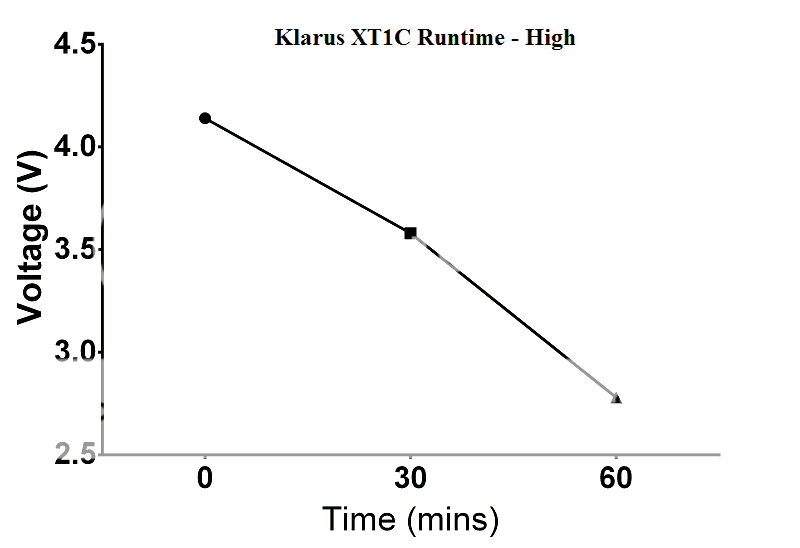
Beamshots
Once again, Klarus has a beautiful, clean beam from an XP-L HI. This made me happy, because I've noticed a lot of XP-L HI lights (such as the Olight M20 and M2X) have a greenish tint, especially on the lower power levels. So far, this is the 4th Klarus light I've used and every single one has a nice, non-green beam.
Coupling the XP-L HI emitter with a short, smooth reflector gives you a nice, tight hotspot which isn't usually seen in a light of this size. It's a clever coupling, and the use of the smooth reflector gives you a defined hotspot. Some people prefer textured reflectors deliberately to smooth out issues with an LED, but here it's just not needed at all.
So, on to some photos!
Here we have a series of similar lights from around 10 metres away. The reason I use this garage is that the white part reflects a bunch of light, while the garage door absorbs it, so the camera actually picks up a decent view of the hot spot. It also lets you see a bit of the spill leading into it, as anything you can see on camera is hit by some spill.
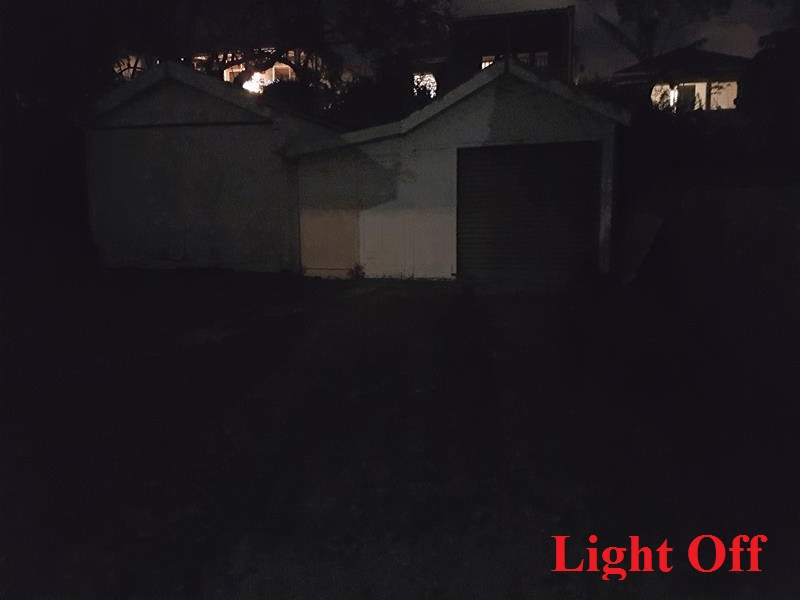
Next we have a view of the same lights against a brick wall, once again showing the hotspot and some spill. They're all pointed at the odd brick in the middle, with around 5 metres of distance.
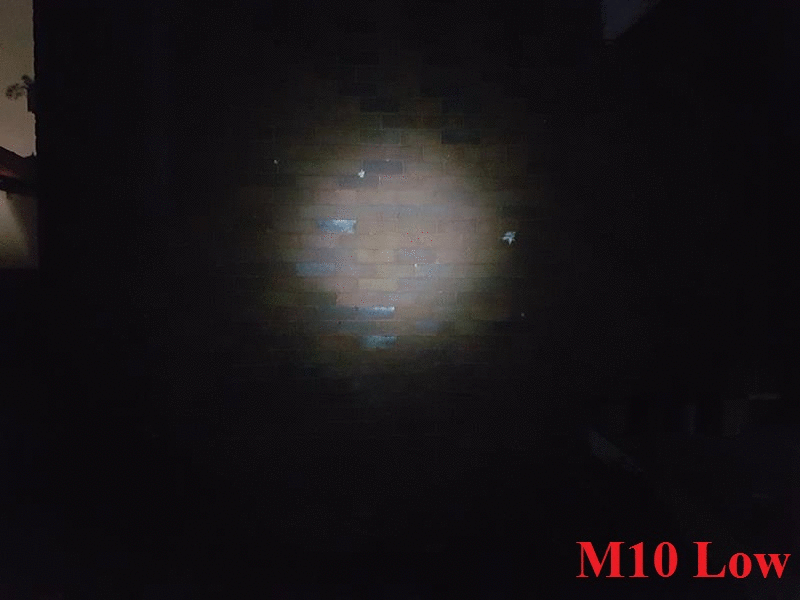
This last set is looking at a dead flower for some colour rendition. As with most cool white lights, the colour feels a little drained and lifeless in comparison to neutral white and the famed Nichia 219. However, both lights give a pretty decent amount of definition.
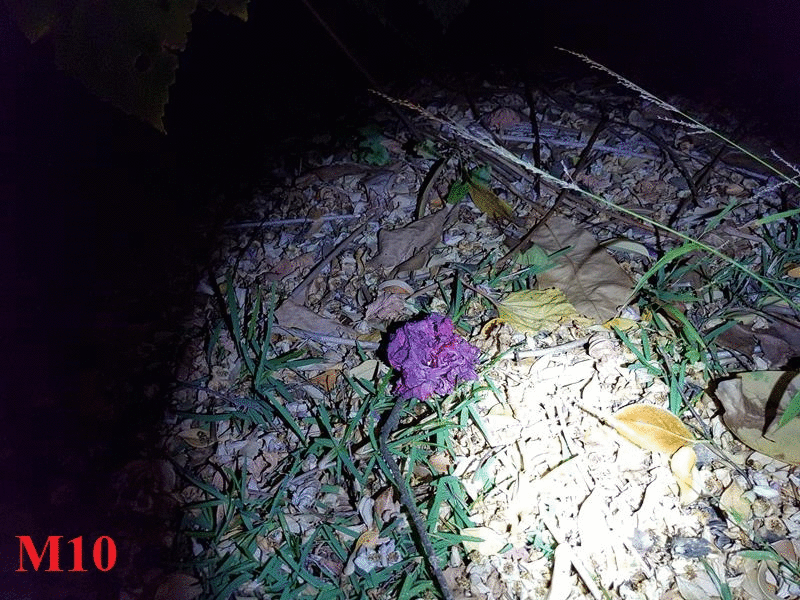
Finally, here are some comparison shots with the M10, both are on high.
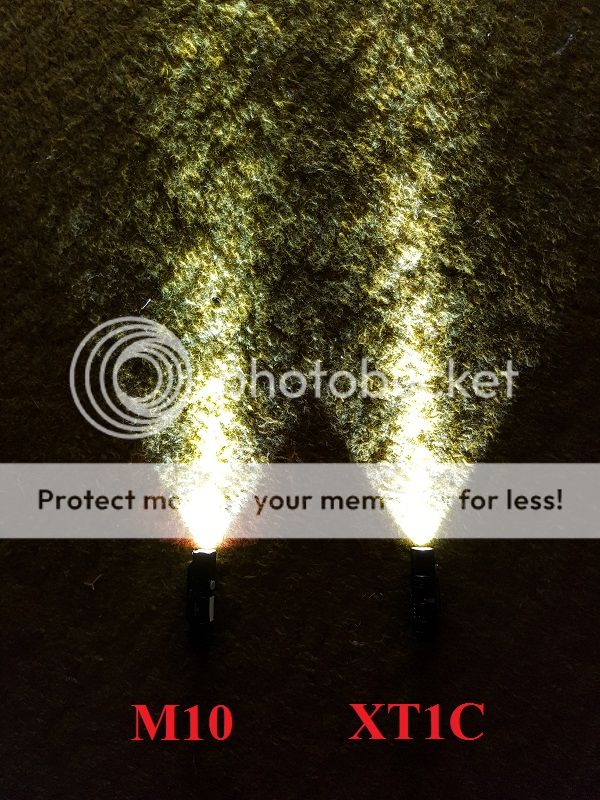
Conclusions
My initial excitement for the XT1C was as a replacement for the Olight M10. In this regard, I think I've found it. I may still swap back occasionally for sentimental reasons, but this is a great light for keeping on your belt. Yes, it's marketed for police and hunters, but I think it's a good little light for general use. Some people might be better off carrying something like the Olight S1 for the really, really small size, but if you're after a light using a single CR123 with a tail switch, this may very well be it.
My only hesitation when it comes to recommending it to my family members seems to come down to rechargeability – 16340 batteries don't last as long as I'd like on high (this is a general thing for all single CR123 lights), so it would be nice to just plug it in for easy recharging. If I got this light for them, I'd either buy a bunch of spare CR123 primaries, or I'd get them a small li-ion charger. Probably the latter, so they can keep it topped up. As a light for the women that I know, the instant access to strobe is a great idea. My girlfriend, for example, wants to just squish down the tail and have that strobe come out the other end. The inclusion of interchangeable bezels would have been a nice idea, but as it stands, the XT1C is a powerful, reliable light that you can take almost anywhere. I highly recommend it.
Disclaimer: This light was sent to me for free by Klarus. However, all opinions presented here are mine and I stand by them.
Manufacturer's Specifications
Emitter: CREE XP-L HI V3 (Cool White)
210 m throw
Type III Anodised Aluminium
Smooth Reflector
Strengthened ultra-clear glass lens with anti-reflective coating
Battery type: CR123A x 1, 16340 x 1 (dual springs for impact resistance)
· Working voltage of 2.0V-4.2V,
· Comes with 1x 700 mAh Klarus 16340 battery
2 groups of modes
· Tactical setting
· Hunting setting
Pocket clip – acts as an anti-roll device
Dual tail switches,
Instant strobe (from off)
Water-proof to 2 m (IPX-8 standard)
Impact resistant to 1 m
Length x diameter (head / body): 85 x 25.2 / 23.2 mm
Weight: 47.5 (without batteries)
ITS Smart Temperature Control System
Output – Manufacturer's Specifications
Since the FL-1 standard is supposed to be based on the included battery, these run times from Klarus should be based on their 700 mAh battery. I couldn't measure tailcap current, as the light disassembles in such a way that it was exceedingly difficult.
On 16340
High (700 lumens): 50 mins
Mid (100 lumens): 3 h
Low (5 lumens): 53 h
Strobe (700 lumens): 1 h 40 mins
SOS (100 lumens): 9 h
Peak Beam Intensity: 11,025 candela (210 metre range)
On CR123
High (400 lumens): 1.5 h
Mid (100 lumens): 5 h
Low (5 lumens): 108 h
Strobe (400 lumens): 3 h
SOS (100 lumens): 15 h
Peak Beam Intensity: unknown
Included in Package
1x Klarus XT1C Flashlight
1x Klarus 700 mAh ICR 16340 battery
1x Lanyard
1x Spare O-Ring
1x Pocket clip
1x User Manual
Initial Impressions
I am a massive, massive fan of the Klarus XT11S, but wanted something a little more portable for when I couldn't pop it in my jacket. I love my Olight M10, but since Olight wasn't planning to make a new version, I've been looking for something more current as a single CR123 light. I got rather excited when Klarus announced the XT1C, and told my girlfriend if I couldn't get one to review, I'd buy it anyway. Fortunately, I managed to get a review sample in the interim. Unfortunately for my girlfriend, I'm probably going to buy some more of them when my income stabilises.
The light comes in a soft plastic box. Yes, it looks cheap, but I prefer it this way – I'm sick of feeling like I need to keep boxes because they're more solid. When they're nice and cheap I can throw it out right after opening.


Like the XT11S before it, this light is solidly built. However, rather than just shrink down the XT11S, Klarus seems to have just taken the elements that made it work and rebuilt a smaller light from scratch with the main goal of portability. The side button is gone, the crenellations are gone and so is the USB recharging. What functionally remains is the beautiful XP-L HI beam and dual tail switches.
The first thing you notice when you turn it on is that the mechanical on/off switch has been replaced by an electrical switch. Some hate these, some love them. I was surprised, but it works quite well, and likely contributes to the size of the light.

By dropping the additional mode group on the XT11S and the control by the side switch, the user interface has been greatly simplified. It's now a light you can just hand to somebody, although there's a chance they'll strobe themselves.
Physical Characteristics
This thing is a baby tank. It's pretty similar in size to the Olight M10, although slightly shorter. There aren't any crenellations, so it's less likely to be considered a weapon anywhere. I kind of miss the crenellations, and legitimately used them to check if the light is on. I think Klarus would have done well to include a removable and interchangeable bezel to allow users to decide on this for themselves. However, as it's designed to be a back-up, ultraportable light this is forgivable. The pocket clip is mounted nicely and stays where you leave it.

There are cutaways on the tail cap shroud, but the light can still tailstand. This isn't a very stable tailstand at all, but it's physically possible. The LED is nicely centered and the diamond knurling is quite clean, if minimal. A little more knurling would be good, but it didn't slip out of my hands as it is. The light is controlled by just 2 switches. One is an electrical on/off switch (which I'll refer to as the tail switch) and a separate electrical mode/strobe switch (I'll refer to this as the flipper). As mentioned elsewhere in this review, Klarus has opted for a digital/electrical switch rather than a mechanical one. I miss the feel of the mechanical switch, but the digital switch does work quite well. You don't get a momentary mode but it's much faster to push.

The feels slightly heavier than the Olight M10, but only barely. I keep it on my belt and frequently forget that it's there. I would prefer to have built-in USB charging, but once again, it would appear that Klarus sacrificed this to shrink the light as far as they could. It's acceptable, but a little sad considering how brilliantly this feature was integrated in the XT11S. Dropping the light a few times didn't cause any damage to the light, even the flipper. So I dropped it out of my second storey window onto the grass outside. It was still fine. Many people think the flipper switch is a structural weak point, but in using 3 lights with these, I haven't seen anything to suggest this. I even pulled it back all the way, and it just flips right back. It's not actually a switch itself - it's mounted just above another electrical switch. It just gives you better surface area to push down on, and physically differentiates it from the on/off switch. The only problem is that it's mounted a little loosely - this is intentional, to allow you to press the flipper down freely, but if you shake it you can hear it gently rattle. Once again, not really a problem in use at all, but some of us are sticklers.
The interior of the light is 17 mm wide, happily handling the ~16.5 mm included battery without any battery rattle at all.

The light handles heat decently. It gets hot after only a couple of minutes, but never went over 48 °C. For me, my hand burns at temperatures above 40°C, but most people I know can easily tolerate 50°C.
User Interface and Modes
XT11S allows you to choose between 2 groups of modes, both of which feature instant high mode by pushing the tail switch from off. The flipper also acts as a mode selection switch once the light is turned on.
Switching between groups is easy once you get used to it, though the manual is a little confusing at first. Basically, from ON you hold the tail switch for 5 seconds. You need to just keep holding the button down until the light starts flashing like a low strobe. While continuing to hold it down, you press the flipper switch to cycle between groups. The light will then flash either once or twice.
The mode groups are (in order):
1 - Tactical group: On this setting, the tail switch activates high and the flipper activates strobe as a momentary switch. Holding the flipper down for two seconds leaves the strobe on continuously until you press the flipper again. If the high switch is activated, pushing the flipper then cycles down from high to medium, then to low and back to high again. Holding the flipper down for 2 seconds while in normal usage activates the strobe. Pressing the flipper down again takes you out of strobe to high.
2 - Hunting group: The tail switch activates high, the flipper switch activates momentary low. Holding the flipper down for two seconds leaves the light on continuously until you hold the flipper for another 2 seconds or the tail switch again. Pressing the flipper while the light is already on will cycle through modes, but this time in reverse – low, medium, high. Holding the flipper for more than 3 seconds when the light is on will activate SOS. There is no strobe in this group.
Once a group is set, you can't really accidentally change it, so I like that getting to the group is a bit laborious. You only really need to change it a couple of times to figure out what group is best for your needs. I liked the hunting mode on the XT11S, but preferred the tactical mode on the XT1C. This is because the side switch on the XT11S allows for strobe, whereas there is no strobe on hunting mode on the XT1C. It's quite easy for me to use high and strobe urgently, and spend half a second longer switching to low when needed. I might actually switch to using this on the XT11S now too. My girlfriend would rather have instant access to strobe rather than messing around with clicks, so I'll likely pick one up for her eventually.
For police officers (likely the intended market), the conventional tactical mode also makes a lot of sense, as in an emergency they would probably need either the strobe or lots of light. They could activate the light in high and switch to low for things like reading documents. This intended use is the reason that I don't mind a lack of moonlight mode, although it would have been useful to add moonlight to the hunting mode grouping rather than having an SOS.
It's a cleverly designed and streamlined UI, and I think Klarus made good choices in what they kept and removed. However, on a CR123 this light puts out 400 lumens for its high mode, and this gets bumped up to 700 lumens with an RCR123. Rather than replace the high mode, I would have liked to see RCR123 activate an additional turbo mode, retaining the high mode for extended run times with higher levels of light. Still, this keeps it nice and simple.
Run time
I don't do exhaustive run-time tests, as I don't believe my ability to measure lumens by sight is accurate. At best, I can do battery voltage checks and measurement of the peak beam intensity.
I tested the light for 1 hour on the highest setting, measuring the battery voltage every 30 minutes. A fully charged battery (4.14 V on this one) dropped to 3.58 V after 30 minutes and 2.78 V after 60 mins (Figure 4). However, after the light was turned off for the 2nd measurement, it wouldn't turn back on. It was also exceedingly dim, but since this was beyond the 50 mins stated run time I'm not surprised. Once again, this is the light you take when you don't know you'll need a light, so it's not meant to be blinding forever.

Beamshots
Once again, Klarus has a beautiful, clean beam from an XP-L HI. This made me happy, because I've noticed a lot of XP-L HI lights (such as the Olight M20 and M2X) have a greenish tint, especially on the lower power levels. So far, this is the 4th Klarus light I've used and every single one has a nice, non-green beam.
Coupling the XP-L HI emitter with a short, smooth reflector gives you a nice, tight hotspot which isn't usually seen in a light of this size. It's a clever coupling, and the use of the smooth reflector gives you a defined hotspot. Some people prefer textured reflectors deliberately to smooth out issues with an LED, but here it's just not needed at all.
So, on to some photos!
Here we have a series of similar lights from around 10 metres away. The reason I use this garage is that the white part reflects a bunch of light, while the garage door absorbs it, so the camera actually picks up a decent view of the hot spot. It also lets you see a bit of the spill leading into it, as anything you can see on camera is hit by some spill.

Next we have a view of the same lights against a brick wall, once again showing the hotspot and some spill. They're all pointed at the odd brick in the middle, with around 5 metres of distance.

This last set is looking at a dead flower for some colour rendition. As with most cool white lights, the colour feels a little drained and lifeless in comparison to neutral white and the famed Nichia 219. However, both lights give a pretty decent amount of definition.

Finally, here are some comparison shots with the M10, both are on high.

Conclusions
My initial excitement for the XT1C was as a replacement for the Olight M10. In this regard, I think I've found it. I may still swap back occasionally for sentimental reasons, but this is a great light for keeping on your belt. Yes, it's marketed for police and hunters, but I think it's a good little light for general use. Some people might be better off carrying something like the Olight S1 for the really, really small size, but if you're after a light using a single CR123 with a tail switch, this may very well be it.
My only hesitation when it comes to recommending it to my family members seems to come down to rechargeability – 16340 batteries don't last as long as I'd like on high (this is a general thing for all single CR123 lights), so it would be nice to just plug it in for easy recharging. If I got this light for them, I'd either buy a bunch of spare CR123 primaries, or I'd get them a small li-ion charger. Probably the latter, so they can keep it topped up. As a light for the women that I know, the instant access to strobe is a great idea. My girlfriend, for example, wants to just squish down the tail and have that strobe come out the other end. The inclusion of interchangeable bezels would have been a nice idea, but as it stands, the XT1C is a powerful, reliable light that you can take almost anywhere. I highly recommend it.
Last edited:

